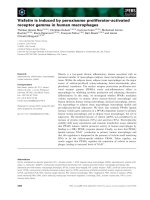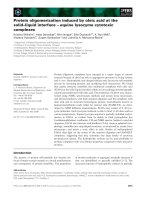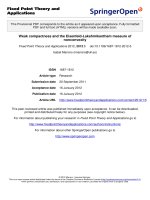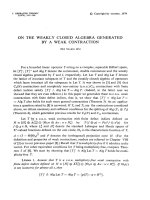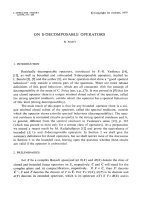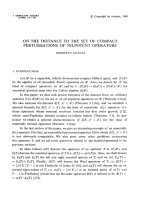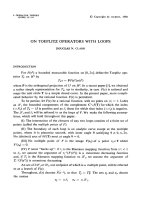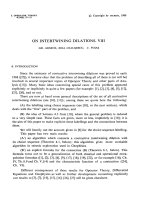Báo cáo toán học: "On subgraphs induced by transversals in vertex-partitions of graphs" potx
Bạn đang xem bản rút gọn của tài liệu. Xem và tải ngay bản đầy đủ của tài liệu tại đây (171.49 KB, 11 trang )
On subgraphs induced by transversals in
vertex-partitions of graphs
Maria Axenovich
Department of Mathematics
Iowa State University, Ames, IA 50011, USA
Submitted: Mar 18, 2005; Accepted: Mar 30, 2006; Published: Apr 4, 2006
MR Subject Classifications: 05C15
Keywords: vertex-colorings, Ramsey, induced, transversals, rainbow, multicolored
Abstract
For a fixed graph H on k vertices, we investigate the graphs, G, such that
for any partition of the vertices of G into k color classes, there is a transversal
of that partition inducing H. For every integer k ≥ 1, we find a family F of
at most six graphs on k vertices such that the following holds. If H/∈F,then
for any graph G on at least 4k − 1 vertices, there is a k-coloring of vertices of
G avoiding totally multicolored induced subgraphs isomorphic to H.Thus,we
provide a vertex-induced anti-Ramsey result, extending the induced-vertex-Ramsey
theorems by Deuber, R¨odl et al.
1 Introduction
Let G =(V,E) be a graph. Let c : V (G) → [k] be a vertex-coloring of G.WesaythatG
is monochromatic under c if all vertices have the same color and we say that G is rainbow
or totally m ulticolored if all vertices of G have distinct colors. Investigating the existence
of monochromatic or rainbow subgraphs isomorphic to H in vertex-colored graphs, the
following questions naturally arise:
Question M: Can one find a small graph G such that in any vertex-coloring of G with
fixed number of colors, there is an induced monochromatic subgraph isomorphic to H?
Question M-R: Can one find a small graph G so that any vertex coloring of G contains
an induced subgraph isomorphic to H which is either monochromatic or rainbow?
Question R: Can one find a large graph G such that any vertex-coloring of G in a fixed
number of colors has a rainbow induced subgraph isomorphic to H?
the electronic journal of combinatorics 13 (2006), #R36 1
The first two questions are well-studied, e.g., [7], [8], [2]. Together with specific bounds
given by Brown and R¨odl [3], the following is known:
Theorem 1 (Vertex-Induced Graph Ramsey Theorem). For any graph H, any
integer t, t ≥ 2, there exists a graph R
t
(H) such that if the vertices of R
t
(H) are col-
ored with t colors then there is an induced subgraph of R
t
(H) isomorphic to H which is
monochromatic. Let the smallest order of such a graph be r
t
(H). There are constants C
1
,
C
2
such that
C
1
k
2
≤ max{r
t
(H)) : |V (H)| = k}≤C
2
k
2
log
2
k.
The topic of the second question belongs to the area of “canonization”, see, for example, a
survey by Deuber [5]. The following result of Eaton and R¨odl [6] provides specific bounds
for vertex-colorings of graphs.
Theorem 2 (Vertex-Induced-Canonical Graph Ramsey Theorem). For any graph
H, there is a graph R
can
(H) such that if R
can
(H) is vertex-colored then there is an induced
subgraph of R
can
(H) isomorphic to H which is either monochromatic or rainbow. Let the
smallest order of such a graph be r
can
(H). There is a constant C such that
Ck
3
≤ max{r
can
(H):|V (H)| = k}≤k
4
log k.
In this paper we initiate the study of Question R when the number of colors in the
coloring corresponds to the number of vertices in a graph H. We call a vertex-coloring
using exactly k colors a k-coloring. In this manuscript we consider only simple graphs
with no loops or multiple edges.
Definition 3. For a fixed graph H on k vertices, let f(H)bethemaximumorderofa
graph G such that any coloring of V (G)ink colors has an induced rainbow subgraph
isomorphic to H.Notethatf(H) ≥ k.
Since a vertex-coloring of G gives a partition of vertices, finding a rainbow induced copy
ofagraphH corresponds to finding a copy of H induced by a transversal of this partition.
Note that f(H)=∞ if and only if for any n
0
∈ N there is n>n
0
and a graph G on n
vertices such that any k-coloring of vertices of G produces a rainbow induced copy of H.
The results we obtain have a flavor quite different from of those answering Questions M
and M-R. In particular, there are few exceptional graphs for which function f is not finite.
Let Λ be a graph on 4 vertices with exactly two adjacent edges and one isolated vertex.
Let K
n
,E
n
,S
n
be a complete graph, an empty graph and a star on n vertices, respectively.
We define a class of graphs
F = {K
n
,E
n
,S
n
, S
n
, Λ, Λ:n ∈ N}.
Note that any graph on at most three vertices is in F.
the electronic journal of combinatorics 13 (2006), #R36 2
Theorem 4. Let H be a graph on k vertices. If H ∈Fthen f(H)=∞, otherwise
f(H) ≤ 4k − 2.
Corollary 1. Let H be a graph on k vertices, H/∈F. For every graph G on at least 4k−1
vertices there is a k-vertex coloring of G avoiding rainbow induced subgraphs isomorphic
to H.
2 Proof of Theorem 4
Let H be a graph on k vertices and let In(H) be the set of graphs on at most k − 1
vertices which are isomorphic to induced subgraphs of H.
One of our tools is the following theorem of Akiyama, Exoo and Harary, later strengthened
by Bos´ak.
Proposition 1 ( [1], [4]). Let G be a graph on n vertices such that all induced subgraphs
of G on t vertices have the same size. If 2 ≤ t ≤ n − 2 then G is either a complete graph
or an empty graph.
Proposition 2. Let H be a graph on k vertices. If G is a graph on at least k vertices
such that G has an induced subgraph on at most k − 1 vertices not isomorphic to any
graph from In(H), then there is a k-coloring of G with no rainbow induced copy of H.
Proof. Let a set, S,ofatmostk − 1 vertices in G induce a graph not in In(H). Color the
vertices of S with colors 1, 2, ,|S| and assign all colors from {|S| +1, ,k} to other
vertices arbitrarily. Any rainbow subgraph of G on k vertices must use all of the vertices
from S, but these vertices do not induce a subgraph of H. Therefore there is no rainbow
induced copy of H in this vertex-coloring of G.
We call a graph G, H-good if any induced subgraph of G on at most |V (H)|−1
vertices is isomorphic to some graph from In(H).
Corollary 2. Let H/∈F be a regular graph on k vertices. Then f(H)=k.
Proof. Note that each graph in In(H)onk − 1 vertices has the same size. Let G be a
graph on k + 1 vertices. By Proposition 2 we can assume that G is H-good. Thus all
(k − 1)-subgraphs of G have the same size. It follows from Proposition 1 that G is either
a complete or an empty graph. Therefore G does not contain H as an induced subgraph
and any k-coloring of G does not result in a rainbow induced copy of H.
We use the following notations for a graph H =(V, E). Let α(H)bethesizeofthe
largest independent set of H,letω(H) be the order of the largest complete subgraph of
H.Letδ(H), ∆(H) be the minimum and the maximum degrees of H respectively. For
two vertices x, y, such that {x, y} /∈ E, e = {x, y} is a non-edge, for a vertex v, d(v)
and cd(v) are the degree and the codegree of v, i.e., the number of edges and non-edges
the electronic journal of combinatorics 13 (2006), #R36 3
incident to v, respectively. A (k − 1)-subgraph of H is an induced subgraph of H on k − 1
vertices. For all other definitions and notations we refer the reader to [9].
Next several lemmas provide some preliminary results for the proof of Theorem 4. We
consider the graph H according to the following cases:
a) α(H)=k − 1orw(H)=k − 1,
b) 2 ≤ δ(H) ≤ ∆(H) ≤ k − 3,
c) δ(H) ≤ 1or∆(H) ≥ k − 2.
The cases a) and b) give us easy upper bounds on f(H), the case c) requires some more
delicate analysis. The first lemma follows immediately from the definition of function f.
Lemma 1. f(H)=f(
H).
Lemma 2. Let H be a graph on k vertices such that 2 ≤ δ(H) ≤ ∆(H) ≤ k − 3. Then
f(H) ≤ 2k − 6.
Proof. If a graph G has a vertex of degree at least k − 2orofcodegreeatleastk − 3,
then G contains a subgraph on k − 1 vertices not in In(H) and by Proposition 2, there
is a k-coloring of G avoiding rainbow induced copies of H. Therefore, if any k-coloring
of G contains a rainbow induced copy of H then for v ∈ V (G)wehave|V (G)|≤d(v)+
cd(v)+1≤ (k − 3) + (k − 4) + 1 = 2k − 6.
Lemma 3. Let H/∈F be a graph on k vertices, such that α(H)=k − 1 or such that
w(H)=k − 1. Then f(H)=k,fork ≥ 5 and f(H)=k +2for k =4.
Proof. Let H be a graph on k vertices with α(H)=k − 1, H/∈F.ThenH is a disjoint
union of a star with k
edges and k − k
− 1 isolated vertices, 1 ≤ k
≤ k − 2.
Assume first that k ≥ 5. Let G be a graph on n vertices, n ≥ k +1. If G has two
nonadjacent edges e, e
, or a triangle, or no edges at all, by Proposition 2 there is a coloring
of G avoiding a rainbow induced copy of H. Therefore, G must be a disjoint union of a
star S with l edges and n − l − 1 isolated vertices, 1 ≤ l ≤ n − 1. Then either l>k
or
n − l − 1 >k− k
− 1. If l>k
, we can use colors from {1, ,k
+1} on the vertices of
S and colors from {k
+2, ,k} on isolated vertices of G.Ifn − l − 1 >k− k
− 1then
we can use colors from {1, ,k− k
} on isolated vertices of G and other colors on the
vertices of S. These colorings do not contain an induced rainbow subgraph isomorphic
to H.
Let k =4.SinceH/∈F,wehavethatH is a disjoint union of an edge and two vertices.
IfagraphG has two adjacent edges e, e
, we are done by Proposition 2. Otherwise, G is
a vertex disjoint union of isolated edges and vertices. Lets color G so that the adjacent
vertices get the same color. This coloring does not contain an induced rainbow copy of
H.Moreover,if| V (G)|≥7 then there is such a coloring using 4 colors. Thus, f(H) < 7.
On the other hand, any 4-coloring of a graph G consisting of three disjoint edges gives a
rainbow induced H,thusf (H) ≥ 6. We have then that f(H)=6.
If w(H)=k − 1, Lemma 1 implies the same result.
the electronic journal of combinatorics 13 (2006), #R36 4
Lemma 4. Let H be a graph on k vertices, H/∈F, α(H) <k− 1, ω(H) <k− 1.IfH
has at least two nontrivial components then f (H) ≤ 2k − 1.
Proof. Note that if H has at least two nontrivial components and δ(H) ≥ 2, then we are
done by Lemma 2. Let m be the largest order of a connected component in H.LetG be a
graph on n ≥ 2k vertices. We can assume by Proposition 2 that G is H-good. Then there
is no component in G of order larger than m.Moreover,sinceH is contained in G as an
induced subgraph, all components of H of order m appear in G as connected components.
Let F
1
,F
2
, ,F
t
be components of G of order m,letx
i
,y
i
∈ V (F
i
), i =1, ,t. Assign
color i to both vertices x
i
and y
i
, i =1, ,t, and assign all colors from {t +1, ,k}
to other vertices arbitrarily. Since k ≤ n/2, t ≤ n/2, we have that t + k ≤ n and such
coloring exists. Consider a copy of H in G. It contains at least one of the components of
order m, thus it has at least two vertices of the same color. Therefore there is no rainbow
induced subgraph of G isomorphic to H in this coloring.
Lemma 5. Let H/∈Fbe a graph on k vertices such that δ(H) ≤ 1, α(H) <k− 1 and
w(H) <k− 1. Then f(H) ≤ 4k − 2.
Proof. Let H be a graph on k vertices, H/∈Fsuch that α(H) <k− 1andω(H) <k− 1.
Let G be a graph on n ≥ 4k − 1 vertices. We can assume by Proposition 2 that G is
H-good.
Claim 0. If all graphs from In(H)onk − 1 vertices with a spanning star are isomorphic
or do not exist, then ∆(G) ≤ k − 1. If all graphs from In(H)onk − 1 vertices with an
isolated vertex are isomorphic or do not exist, then ∆(
G) ≤ k − 1.
To prove the Claim, assume that all graphs from In(H)onk − 1 vertices with a
spanning star are isomorphic. Consider S, a neighborhood of a vertex v of maximum
degree in G. Then, all subsets of S of size k − 2 induce isomorphic graphs. Therefore,
if |S|≥k we have, by Proposition 1, that S induces an empty or a complete graph on
at least k vertices, a contradiction. Thus, |S| =∆(v) ≤ k − 1. If there is no graph from
In(H)onk −1 vertices with a spanning star and G has a vertex v of degree at least k −2,
then v and k −2 of its neighbors induce a subgraph with a spanning star on k − 1 vertices,
a contradiction. The second statement can be proved in the same manner, concluding the
proofofClaim0.
Case 1. δ(H)=0.
We can assume by Lemma 4 that H has exactly one nontrivial component. Observe
that either there is no (k − 1)-vertex subgraph of H with a spanning star, or all such
subgraphs are isomorphic. Thus, by Claim 0, ∆(G) ≤ k − 1. Consider two adjacent
vertices of G, u and v.ThereisasetT of vertices, |T |≥n − 2 − 2(k − 1) = n − 2k,such
that neither u nor v is adjacent to any vertex in T . Observe also, that since G has no
independent set of size k − 1, the largest size of an independent set induced by vertices of
T is at most k − 2. Let T
⊂ T induce the largest independent set in G[T ]. Then, for each
the electronic journal of combinatorics 13 (2006), #R36 5
x ∈ T \ T
,thereisx
∈ T
such that xx
∈ E(G). Since |T \ T
|≥n −2k − k +2≥ k,itis
clear that we can build a subgraph of G[T ]onk −3 vertices with no isolated vertices using
some vertices from T \ T
and some of their neighbors from T
(provided that k ≥ 5).
Together with uv it forms a subgraph on (k − 1) vertices with at least two nontrivial
components and no isolated vertices. But each disconnected subgraph of H on k − 1
vertices has an isolated vertex, a contradiction.
Let k =4. Sinceδ(H)=0andα(H) < 3, H must be a disjoint union of an isolated
vertex and K
3
.ButthenH ∈F, which is impossible.
Case 2. δ(H)=1.
Lets call the vertices of degree 1, leaves. We can assume that H is connected by
Lemma 4.
Case 2.1. All leaves in H have a common neighbor, v.
Then all (k −1)-subgraphs of H which have an isolated vertex are isomorphic to H −v,
thus, by Claim 0, we have that ∆(
G) ≤ k −1. Note that all (k −1)-subgraphs of H having
two adjacent vertices of degree k − 2 are either isomorphic or do not exist. Consider x, y,
two adjacent vertices of G. Since the codegree of each vertex is at most k − 1wehave
that there is a set S of vertices, |S|≥n − 2 − 2(k − 1) ≥ k − 1, such that each vertex of
S is adjacent to x and to y.Thus,all(k − 3)-subsets of S induce isomorphic graphs, and
S must induce a complete or an empty graph on at least k − 1 vertices by Proposition 1,
a contradiction.
Case 2.2. There are at least two leaves in H which do not have a common neighbor.
It is easy to see that either H does not have a vertex of degree k −2 or all subgraphs of
H on k −1 vertices with a spanning star are isomorphic. Then, by Claim 0, ∆(G) ≤ k −1.
Consider a set S of vertices of G inducing H and let S
⊆ S correspond to the set of leaves
in H.Letl be the largest number of leaves in H having a common neighbor, let x(l)be
the number of distinct vertices in H each adjacent to l leaves.
If l ≤ 2or(l =3andx(l) = 1) then all (k − 1)-subgraphs of H with at least three
isolated vertices either do not exist or isomorphic. Consider three pairwise nonadjacent
vertices w, w
,w
in G.Since∆(G) ≤ k − 1, there are at least n − 3 − 3(k − 1) ≥ k − 1
vertices of G non-adjacent to either of w, w
,w
. This is either impossible, or these vertices
must induce an independent set or a clique, a contradiction.
Thus, we can assume that there are at least two distinct vertices in H adjacent to at
least three leaves each. Let u, u
∈ S correspond to these vertices, and let s, s
∈ N(u)∩S,
s
∈ N(u
) ∩ S.SinceV \ S has size at least k − 1, it does not induce an independent
set; thus there is an edge vv
, v,v
∈ V \ S.Ifv,v
are not adjacent to any vertex in
S,thenG[S \{s, s
,s
}∪{v,v
}]isa(k − 1)-subgraph of G with an isolated edge, no
isolated vertices and with |S
|−1 leaves. This is impossible, since each (k − 1)-subgraph
of H with an isolated edge and no isolated vertices has at least |S
| leaves. If v or v
is
adjacent to some vertex q ∈ S (we can always assume that q/∈{s, s
,s
} by choosing
s, s
,s
accordingly), then G[S \{s, s
,s
}∪{v,v
}] is a connected (k − 1)-subgraph of G
the electronic journal of combinatorics 13 (2006), #R36 6
with at most |S
|−2 leaves. This is impossible since each connected subgraph of H has
at least |S
|−1leaves.
Now, we can quickly complete the proof of the main theorem using the result about
the special graph Λ proven in the next section.
Proof of Theorem 4. If H = S
k
,thenanyk-coloring of S
n
, n ≥ k induces a rainbow H.If
H = K
k
,thenanyk-coloring of K
n
, n ≥ k induces a rainbow H. Using Proposition 3 for
a graph Λ and the fact that f(H)=f(
H) we have now established that for any H ∈F,
f(H)=∞.
Now, assume that H is a graph on k vertices, H/∈F.Ifα(H)=k−1orω(H)=k −1,
then, by Lemma 3, f (H) ≤ k +2. Ifα(H) <k− 1andω(H) <k− 1thenatleastone
of the following holds:
1) 2 ≤ δ(H) ≤ ∆(H) ≤ k − 3, and by Lemma 2, f(H) ≤ 2k − 6,
2) δ(H) ≤ 1, and by Lemmas 4 and 5, f (H) ≤ 4k − 2,
3) ∆(H) ≥ k − 2, by 2) and Lemma 1, f (H) ≤ 4k − 2.
3 Treating Λ
Definition 5. Let G(m)=(V,E),
V = {v(i, j): 1≤ i ≤ 7, 1 ≤ j ≤ m},
E = {v(i, j)v(i +1,k): 1≤ j, k ≤ m, j = k, 1 ≤ i ≤ 7}∪
{v(i, j)v(i +3,j): 1≤ j ≤ m, 1 ≤ i ≤ 7},
addition is taken modulo 7.
We have V = V
1
∪···∪V
7
= L
1
∪···∪L
m
,whereV
i
= {v(i, j): 1≤ j ≤ m},
1 ≤ i ≤ 7, L
j
= {v(i, j): 1≤ i ≤ 7},1≤ j ≤ m.WeshallrefertoV
i
s as vertex parts
and L
i
s as vertex layers. The edge-set of G(m) can be constructed by first taking all
the edges between consecutive (in cyclic order) V
i
s, i =1, ,7 then removing the edges
induced by each layer L
j
, j =1, ,m, and finally adding, for each j =1, ,m,anew
7 cycle induced by L
j
, see Figure 1. Note that G(1) is isomorphic to a 7-cycle, G(2) has
a spanning 14-cycle, and can be drawn as in the Figure 2.
Proposition 3. For any positive integer m and any coloring of V (G(m)) into 4 colors,
there is a rainbow induced subgraph of G isomorphic to Λ.
Proof. We prove the statement, for m =1, 2, 3 and for m>3 use induction. This is a
somewhat tedious but straightforward case analysis.
the electronic journal of combinatorics 13 (2006), #R36 7
VV
V
V
V
V
V
12
7
6
5
4
3
V
V
V
V
V
V
12
3
7
4
5
6
V
VV
V
V
V
V
V
12
7
6
5
4
3
VV
V
V
V
V
V
12
7
6
5
4
3
Figure 1: G(1), G(2), G(3) and G(4)
Claim 1.AnycoloringofG(1) in 4 colors contains an induced rainbow Λ.
Let G(1) have vertices x
1
, ,x
7
and edges x
i
x
i+1
, i =1, ,7, addition taken modulo
7. Assume that there is a 4-coloring c with no induced rainbow Λ. First observe that any
4-coloring of C
7
must have three consecutive vertices with distinct colors, say c(x
i
)=i,
for i =1, 2, 3. Then c(x
5
) =4,c(x
6
) = 4, thus, without loss of generality c(x
4
)=4.
Note that then c(x
7
) =1,c(x
7
) =3. Ifc(x
7
)=4thenx
6
must have color 3, and there
is no color available for x
5
.Ifc(x
7
)=2thenc(x
6
) = 2 and there is no available color for x
5
.
Claim 2. Any coloring of G(2) in 4 colors contains an induced rainbow Λ.
Note that G(2) can be drawn as C
14
with chords as in Figure 2. Let the vertices of
G(2) be x
1
, ,x
14
in order on the cycle and let the edges be x
i
,x
i+1
,x
i+4
, i =1, ,14,
where addition is taken modulo 14. We shall use the fact that the following sets of vertices
the electronic journal of combinatorics 13 (2006), #R36 8
x
x
x
1
2
3
Figure 2: Different drawing of G(2)
induce C
7
and thus cannot use all 4 colors:
{x
i
,x
i+2
,x
i+3
,x
i+4
,x
i−2
,x
i−3
,x
i−4
},
i =1, ,14 and addition is taken modulo 14. We shall also use an easy fact that it is
impossible to have a 4-colored C
4
in G(2).
Case 1. There are three consecutive vertices, using distinct colors, say c(x
i
)=i, i =1, 2, 3.
Then, considering all induced cycles of length 7 containing these three vertices, we see
that the only vertices which could have color 4 are x
4
,x
6
,x
14
or x
12
.
Case 1.1. c(x
4
)=4.
Consider vertex x
8
.Ifc(x
8
)=1then{x
2
,x
3
,x
4
,x
6
,x
8
,x
9
,x
10
} induces a C
7
using
4 colors. If c(x
8
)=2then{x
1
,x
3
,x
4
,x
8
} induces a rainbow Λ. If c(x
8
)=3then
{x
14
,x
1
,x
2
,x
4
,x
6
,x
7
,x
8
} induces a C
7
using 4 colors. Thus x
8
cannot be assigned any
color and this case is impossible.
Case 1.2. c(x
6
)=4.
Consider vertex x
7
.Ifc(x
7
)=1then{x
2
,x
3
,x
6
,x
7
} is a 4-colored C
4
.Ifc(x
7
)=2
then {x
1
,x
3
,x
7
,x
6
} induces a rainbow Λ. If c(x
7
)=3then{x
14
,x
1
,x
2
,x
4
,x
6
,x
7
,x
8
}
induces a C
7
using 4 colors. Therefore x
7
cannot be assigned a color and this case is
impossible as well.
By symmetry c(x
14
) =4andc(x
12
) = 4, so there is no vertex colored 4, a contradiction.
Case 2. There are no three consecutive vertices using distinct colors.
Then, without loss of generality, there are consecutive vertices x
i
,x
i+1
, ,x
j
such
that c(x
i
)=a, c(x
j
)=b and c(x
m
)=c, for i<m<j, such that a, b, c are distinct.
Consider smallest such set of vertices and assume that i =1,a =2,b =3,c =1. Then
clearly, j ≥ 4, moreover j ≤ 5 since otherwise there is a smaller such set.
Case 2.1. j =4.
By considering all induced C
7
containing vertices of colors 1, 2, 3from{x
1
,x
2
,x
3
,x
4
},
and using the fact that x
14
and x
5
cannot have color 4 without creating three consecutive
the electronic journal of combinatorics 13 (2006), #R36 9
vertices of distinct colors, we see that the only vertices which could have color 4 are x
9
and x
10
.Ifc(x
10
) = 4 then consider vertex x
14
.Ifc(x
14
)=3or4thenx
14
,x
1
,x
2
are three
consecutive vertices using distinct colors. If c(x
14
)=2then{x
14
,x
10
,x
4
,x
2
} induces a
rainbow Λ. Thus c(x
14
)=1. Considerx
5
: c(x
5
) =4andc(x
5
) = 2 since otherwise there
are three consecutive vertices of distinct colors. If c(x
5
)=3then{x
2
,x
1
,x
5
,x
9
} induces
arainbowΛ. Ifc(x
5
)=1then{x
4
,x
5
,x
1
,x
9
} induces a rainbow Λ. Thus this case is
impossible. If c(x
9
) = 4 we arrive at a contradiction by symmetry.
Case 2.2. j =5.
By considering all induced C
7
containing vertices of colors 1, 2, 3from{x
1
, ,x
5
}
we see that the only vertex which might, and thus must have color 4 is x
10
.Butthen
{x
10
,x
1
,x
2
,x
5
} induces a rainbow Λ, a contradiction.
Claim 3. Any coloring of G(3) in 4 colors contains an induced rainbow Λ.
Let c be a coloring of G(3) using colors 1, 2, 3, 4 and containing no induced rainbow
copy of Λ. If there is a subgraph of G(3) isomorphic to G(2) and using four colors, there is
a rainbow induced Λ by Claim 2. Therefore, we can assume that each vertex layer of G(3)
has a color used only on its vertices and on no vertex of any other layer. In particular,
assume that color i is used only in L
i
, i =1, 2, 3. So, L
1
uses colors from {1, 4}, L
2
uses
colors from {2, 4},andL
3
uses colors from {3, 4}.
If there is a part, say V
1
,usingcolors1, 2, 3, then it is easy to see that none of the
vertices of V
2
could have color 4 and moreover V
2
must use all three colors 1, 2, 3 again,
in respective layers. This shows that in this case all sets V
i
, i =1, ,7mustuseonly
colors 1, 2, 3 and there is no vertex of color 4, a contradiction. Since there is no part V
i
,
i =1, ,7 using all colors 1, 2, 3, each part must have color 4 on some vertex.
Assume that there is a part, say V
1
, having exactly one vertex of color 4. Without
loss of generality, we have c(v(1, 1)) = 4,c(v(1, 2)) = 2,c(v(1, 3)) = 3, then c(v(7, 1)) =
c(v(2, 1)) = 4. Moreover, c(v(i, 1)) = 1 for i =3, 4, 5, 6, otherwise one of these vertices
together with either {v(2, 1),v(1, 2),v(1, 3)} or with {v(7, 1),v(1, 2),v(1, 3)} induces a
rainbow Λ. Therefore, there is no vertex of color 1 in the graph, a contradiction.
Thus, each part V
i
has at least two vertices of color 4. Then, it is easy to see that
there is always a rainbow induced Λ in such a coloring of G(3), a contradiction.
Induction step. Assume that m ≥ 4. If there is a vertex layer L
i
such that G[V − L
i
]
uses all 4 colors, then, since G[V − L
i
] is isomorphic to G(m − 1), there is a rainbow
induced subgraph isomorphic to Λ. Thus we can assume that each layer L
1
,L
2
, ,L
m
uses a color not present in other layers. It is possible only if m =4,inwhichcaseall
vertices of each layer have the same color. We can assume that all vertices of layer L
i
have color i, i =1, 2, 3, 4. But then it is easy to see that there is an induced rainbow Λ
in this coloring.
the electronic journal of combinatorics 13 (2006), #R36 10
It is interesting to see that if G is a bipartite graph then there is always a coloring of
V (G) in 4 colors avoiding induced rainbow Λ. Indeed, if G is a complete bipartite graph,
it does not have any induced copies of Λ, so any 4-coloring will work. Thus, we can
assume that there are two nonadjacent vertices from different partite sets A and B, x ∈ A
and y ∈ B.Letc(x)=3,c(y)=4,c(N(x)) = 1,c(N(y)) = 2, c(A \ (N(y) ∪{x})) = 1
and c(B \ (N(x) ∪{y} )) = 2. It is easy to see that this coloring does not have a rainbow
induced Λ.
Concluding Remark: We have proven that for any graph H/∈Fon k vertices and any
graph G on 4k − 1 vertices there is a coloring of G in k colors avoiding rainbow induced
subgraph isomorphic to H. Together with definition of f, this implies that
k ≤ max{f(H):|V (H)| = k, H /∈F}≤4k − 2.
There are many classes of graphs for which f(H)=k, which follows, for example, from
Proposition 2. We believe that the above upper bound could be improved to 2k − 1with
a more careful analysis, and, perhaps to k + c,wherec is a constant. As far as the lower
bound is concerned, we have only one example when f(H)=k + 2 for k =4,provided
by Lemma 3. It will be very interesting to see constructions of graphs giving better lower
bounds on f.
References
[1] Akiyama, J., Exoo, G., Harary, F., The graphs with all induced subgraphs isomorphic,
Bull. Malaysian Math. Soc. (2), 2 (1979), no. 1, 43–44.
[2] Borowiecka-Olszewska, M., Drgas-Burchardt, E., Mih´ok, P., Minimal vertex Ramsey
graphs and minimal forbidden subgraphs, Discrete Math., 286 (2004), no. 1-2, 31-36.
[3] Brown, J., R¨odl, V., A Ramsey type problem concerning vertex colorings, J. Combin.
Theory Ser. B, 52 (1991), no. 1, 45–52.
[4] Bos´ak, J., Induced subgraphs, Finite and infinite sets, Vol. I, II (Eger, 1981), Colloq.
Math. Soc. J´anos Bolyai, 37, North-Holland, Amsterdam (1984), 109–118.
[5] Deuber, W. A., Canonization, Combinatorics, Paul Erd˝os is eighty, Bolyai Soc. Math.
Stud., J´anos Bolyai Math. Soc., Budapest, 1 (1993), 107–123,
[6] Eaton, N., R¨odl, V., A canonical Ramsey theorem, Random Structures Algorithms, 3
(1992), no. 4, 427–444.
[7] Graham, R., Rothschild, B., Spencer, J., Ramsey theory, Second edition. Wiley-
Interscience Series in Discrete Mathematics and Optimization, New York, 1990.
[8] Luczak, T., Rucinski, A., Urbanski, S., Vertex Ramsey properties of families of graphs,
J. Combin. Theory Ser. B, 84 (2002), no. 2, 240-248.
[9] West, D., Introduction to Graph Theory, Second Edition, Prentice Hall, 2001.
the electronic journal of combinatorics 13 (2006), #R36 11
